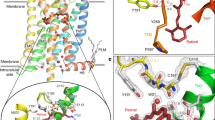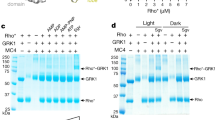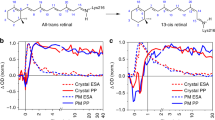Abstract
Photo-isomerization of the 11-cis retinal chromophore activates the mammalian light-receptor rhodopsin1, a representative member of a major superfamily of transmembrane G-protein-coupled receptor proteins (GPCRs) responsible for many cell signal communication pathways. Although low-resolution (5 Å) electron microscopy studies2,3 confirm a seven transmembrane helix bundle as a principal structural component of rhodopsin, the structure of the retinal within this helical bundle is not known in detail. Such information is essential for any theoretical or functional understanding of one of the fastest occurring photoactivation processes in nature, as well as the general mechanism behind GPCR activation4,5,6. Here we determine the three-dimensional structure of 11-cis retinal bound to bovine rhodopsin in the ground state at atomic level using a new high-resolution solid-state NMR method7. Significant structural changes are observed in the retinal following activation by light to the photo-activated MI state of rhodopsin giving the all-trans isomer of the chromophore. These changes are linked directly to the activation of the receptor, providing an insight into the activation mechanism of this class of receptors at a molecular level.
This is a preview of subscription content, access via your institution
Access options
Subscribe to this journal
Receive 51 print issues and online access
$199.00 per year
only $3.90 per issue
Buy this article
- Purchase on Springer Link
- Instant access to full article PDF
Prices may be subject to local taxes which are calculated during checkout



Similar content being viewed by others
References
Birge, R. R. Nature of the primary photochemical events in rhodopsin and bacteriorhodopsin. Biochim. Biophys. Acta 1016, 293– 327 (1990).
Krebs, A., Villa, C., Edwards, P. C. & Schertler, G. F. X. Characterisation of an improved two-dimensional p22121 crystal from bovine rhodopsin. J. Mol. Biol. 282, 991–1003 (1998).
Baldwin, J. M., Schertler, G. F. X. & Unger, V. M. An alpha-carbon template for the transmembrane helices in the rhodopsin family of G-protein-coupled receptors. J. Mol. Biol. 272, 144–164 ( 1997).
Baldwin, J. M. Structure and function of receptors coupled to G proteins. Curr. Opin. Cell Biol. 6, 180–190 (1994).
Donnelly, D. & Findlay, J. B. C. Seven-helix receptors: structure and modelling. Curr. Opin. Struct. Biol. 4, 582–589 (1994).
Herzyk, P. & Hubbard, R. E. Combined biophysical and biochemical information confirms arrangement of transmembrane helices visible from the three-dimensional map of frog rhodopsin. J. Mol. Biol. 281, 741–754 (1998).
Glaubitz, C., Burnett, I. J., Gröbner, G., Mason, A. J. & Watts, A. Deuterium-MAS NMR spectroscopy on oriented membrane proteins: applications to photointermediates of bacteriorhodopsin. J. Am. Chem. Soc. 121, 5787 ( 1999).
Ji, T. H., Grossmann, M. & Ji, I. G Protein-coupled receptors. J. Biol. Chem. 273, 17299–17302 ( 1998).
Altenbach, C., Cai, K., Khorana, H. G. & Hubbell, W. L. Structural features and light-dependent changes in the sequence 306–322 extending from helix VII to the palmitoylation sites in rhodopsin: a site-directed spin-labeling study. Biochemistry 38, 7931– 7937 (1999).
Tan, Q. et al. Absolute sense of twist of the C12–C13 bond of the retinal chromophore in bovine rhodopsin based on exciton-coupled CD spectra of 11,12-dihydroretinal analogues. Angew. Chem Int. Ed. 36, 2089 –2093 (1997).
Buss, V., Kolster, K., Terstegen, F. & Vahrenhorst, R. Absolute sense of twist of the C12–C13 bond of the retinal chromophore in rhodopsin-semiempirical and nonempirical calculations of chiroptical data. Angew. Chem Int. Ed. 37, 1893– 1895 (1998).
Rothschild, K. J., Sanches, R., Hsiao, T. L. & Clark, N. A. A spectroscopic study of rhodopsin alpha-helix orientation. Biophys. J. 31, 53–64 ( 1980).
Jaeger, S. et al. Chromophore structural changes in rhodopsin form nanoseconds to microseconds following pigment photolysis. Proc. Natl Acad. Sci. USA 94, 8557–8562 ( 1997).
Shieh, T., Han, M., Sakmar, T. P. & Smith, S. O. The steric trigger in rhodopsin activation. J. Mol. Biol. 269, 373–384 (1997).
Eilers, M., Reeves, P. J., Ying, W., Khorana, H. G. & Smith, S. O. Magic angle spinning NMR of the protonated retinylidene Schiff base nitrogen in rhodopsin: Expression of 15N-lysine- and 13 C-glycine-labeled opsin in a stable cell line. Proc. Natl Acad. Sci. USA 96, 487– 492 (1999).
Feng, X. et al. Direct determination of a molecular torsional angle in the membrane protein rhodopsin by solid-state NMR. J. Am. Chem. Soc. 119, 6853–6857 (1997).
Verdegem, P. J. E. et al. Retinylidene ligand structure in bovine rhodopsin, metarhodopsin-I, and 10-methylrhodopsin from internuclear distance measurements using 13C-labeling and 1D rotational resonance MAS NMR. Biochemistry 33, 11316–11324 ( 1999).
Feng, X. et al. Determination of a molecular torsional angle in the metarhodopsin-I photointermediate of rhodopsin by double-quantum solid-state NMR. J. Biomol. NMR 16, 1–8 ( 2000).
Gröbner, G. et al. Photoreceptor rhodopsin: structural and conformational study of its chromophore 11-cis retinal in oriented membranes by deuterium solid state NMR. FEBS Lett. 422, 201– 204 (1998).
Gröbner, G. et al. Macroscopic orientation of natural and model membranes for structural studies. Anal. Biochem. 254, 132–138 (1997).
Smith, S. O. et al. Low-temperature solid-state 13C NMR studies of the retinal chromophore in rhodopsin. Biochemistry 26, 1606–1611 (1987).
Hudson, B. S. & Birge, R. R. Angular orientation of the retinyl chromophore of bacteriorhodopsin: Reconciliation of 2H NMR and optical measurements. J. Phys. Chem. A 103, 2274–2281 (1999).
Acknowledgements
We thank P. Fisher and B. Bonev for help, and J. Lugtenburg for discussion and advice. This work was supported by grants to A.W. (MRC, BBSRC, EU TMR, EU Biotech , Magnex, Varian, Bruker and HEFCE); C.G. is supported by a DFG Emmy Noether Fellowship.
Author information
Authors and Affiliations
Corresponding author
Rights and permissions
About this article
Cite this article
Gröbner, G., Burnett, I., Glaubitz, C. et al. Observations of light-induced structural changes of retinal within rhodopsin . Nature 405, 810–813 (2000). https://doi.org/10.1038/35015604
Received:
Accepted:
Issue Date:
DOI: https://doi.org/10.1038/35015604
This article is cited by
-
Neutron reflectometry and NMR spectroscopy of full-length Bcl-2 protein reveal its membrane localization and conformation
Communications Biology (2021)
-
Direct observation of the three regions in α-synuclein that determine its membrane-bound behaviour
Nature Communications (2014)
-
Solid-state NMR in drug design and discovery for membrane-embedded targets
Nature Reviews Drug Discovery (2005)
-
Probing membrane protein orientation and structure using fast magic-angle-spinning solid-state NMR
Journal of Biomolecular NMR (2004)
Comments
By submitting a comment you agree to abide by our Terms and Community Guidelines. If you find something abusive or that does not comply with our terms or guidelines please flag it as inappropriate.



